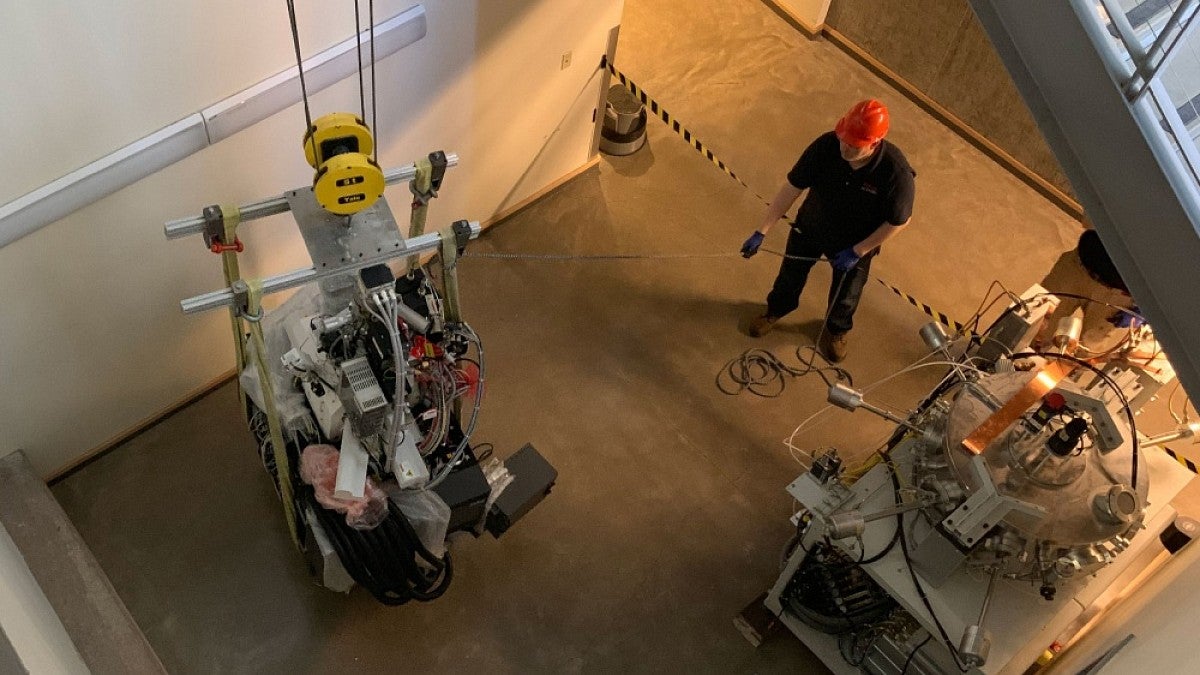A new multi-million-dollar research tool that will let UO scientists and students jump ahead of the technology curve is now being installed in a campus lab.
The plasma focused ion beam instrument, known as the Thermo Scientific Helios Hydra DualBeam, is only the fourth instrument of its kind in the world and the first to be housed at a university or service center in North America. It is similar to a scanning electron microscope but also uses beams of ions rather than electrons to image, etch and analyze materials at nanometer scales.
The acquisition was made possible through a new strategic collaboration with Thermo Fisher Scientific. The relationship promises to further position the UO as a key research and testing site, both for UO researchers and industrial clients who will lease time on the instrument.
“It’s a real win-win-win that will greatly benefit the university, our faculty doing cutting-edge research and our students training for high-tech careers using the world’s most advanced tools and technologies available,” said David Conover, vice president for research and innovation. “We are thrilled to be partnering with Thermo Fisher Scientific to ensure that our research facilities stay ahead of the technology curve.”
As part of the collaboration with Thermo Fisher, the UO will pilot a new instrument acquisition model that could help keep its research facilities at the forefront of science for years to come. The UO will work with Thermo Fisher’s Material Science division to ensure the Helios Hydra DualBeam stays cutting-edge throughout its time on campus.
As new product features are developed, they will be added to the instrument. In turn, UO researchers will provide early feedback on featured applications to help shape future capabilities and functions for use within academic and industry labs.
Even as workers were still unpacking 7-foot-tall wooden crates that housed the instrument during shipping and using a heavy-duty ceiling crane to lower pieces of the tool down a flight of stairs to the Center for Advanced Materials Characterization in Oregon, where the Helios Hydra will be located, Kurt Langworthy, director of the center, had already received inquiries from UO researchers and industrial clients interested in renting time on the machine. The instrument should be operational by the end of the month.
“This will strengthen our position as a top-tier research facility, enabling internal researchers and external partners to investigate materials at scales that are more than 10 times our current limit,” Langworthy said. “Once word gets out that we have this instrument, we will be pretty busy.”
The Helios Hydra will offer new efficiencies for materials science researchers seeking to discover and design new materials and analyze their properties and structure. But it will also serve other kinds of researchers, including biologists who could use the tool for so-called “connectomics” projects that involve mapping neural connections in the brain.
The advanced materials center, one of the UO’s core research facilities, offers high-tech services to researchers, companies and universities.
The collaboration builds on a long history and growing relationship between the UO and Thermo Fisher Scientific, which includes research collaborations, instrument acquisitions, in-kind gifts and opportunities for students.
“DualBeam technology is widely used for sample preparation and 3D materials characterization, and the collaboration with the University of Oregon focuses on bringing this technology to a new level of performance,” said Trisha Rice, vice president and general manager, materials science, at Thermo Fisher.
“In addition to finding the best ion beam match for a variety of samples and materials, it could lead to the ability to characterize previously difficult samples, such as those that contain carbon,” she said. “In addition, we plan to gain new insights and create best practices to optimize sample throughput and quality in the various DualBeam applications, helping researchers publish potentially groundbreaking results.”
The strategic collaboration with Thermo Fisher and addition of the Helios Hydra will also benefit UO students training for high-tech careers in programs like the advanced materials analysis and characterization master’s degree program, a chemistry program facilitated through the center’s labs, and the Master’s Industrial Internship Program, housed in the Phil and Penny Knight Campus for Accelerating Scientific Impact.
Thermo Fisher has been a prominent partner in the internship program for nearly 20 years, with 89 students starting their careers at the company. In 2017, Thermo Fisher provided funding to the internship program in support of its diversity and inclusion efforts.
The master’s program trains students for careers in industry and government labs. It couples industry relevant hands-on coursework with nine-month paid internships in industry, giving students practical experience to springboard their careers.
“Many of our students intern with Thermo Fisher Scientific and go on to have careers there,” said Stacey York, director of the Master’s Industrial Internship Program. “Some even return to the UO to earn doctorates, bringing their learning and experience from internships back to the university.”
Ultimately, Langworthy said, the new partnership will streamline ways to align UO research and industry with the resources offered by Thermo Fisher’s business network. As the new collaboration progresses, the UO will look for more opportunities for large-scale collaborations with Thermo Fisher.
“There is a lot of potential for ongoing partnerships, new discoveries and new ways to attract outside investment for research and sponsorships,” Langworthy said. “We are excited to see what the future holds.”


